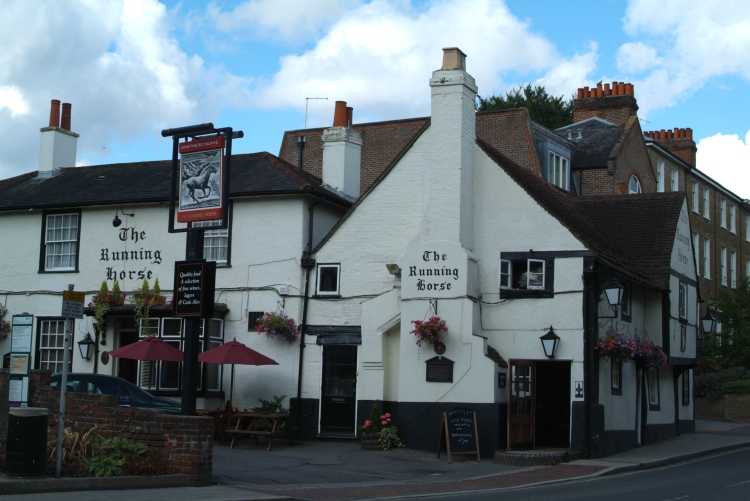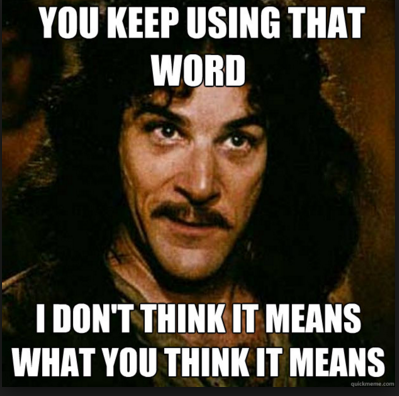In the town of Leatherhead, Surrey beside the River Mole sits a medieval public house. Its white façade and inviting signage beckon passersby to come in to sample their cask real ale. But in addition serving traditional English beer, this specific edifice might also boast a particularly important role to the history of the brew itself.
The pub is none other than The Running Horse and it was here that a woman called Alianora Rumyng was likely working as an alewife when John Skelton wrote his famous satirical poem, The Tunning of Elynour Rumming. And it was her, some scholars have speculated, that inspired the poem in the first place.

(c) MartynDavis CC BY-SA 3.0
As to the veracity of this claim? The names are certainly similar and Alianora was operating during Skelton’s lifetime, but the link is largely conjecture at this point.
But regardless of whether she was the inspiration of the infamous poem or not, Alianora is critical to the study of women and brewing frankly because we know of her at all. So who was she and why do we know about her when so many of the names of alewives have been lost to the annals of history?
We know about Alianora quite simply because she was ripping people off. Apparently.
While there are still ongoing (sometimes heated) debates about serving size, ABV, and even the proper amount of foam, medieval and early modern people were very anxious about being cheated by alewives, and indeed, all tipplers, victuallers, millers, and bakers. Alianora herself, was fined two shillings for selling too expensive ale in too small measures in 1525.[1] And I would like to make a quick note to mention this fine would have been roughly equal to less than a gallon of her own ale, so not, as a fact, particularly large.[2]
Why so small? Because cheating was (very) common, and not always intentional – with some aleswives using whatever cups they had available it wasn’t always easy to keep to the standard legal sizes and regulation in rural areas was difficult. This is not to say, though, that some didn’t do so with impunity: For example, a brewster called Alice in 1364 unabashedly cheated her customers by selling them ridiculously false amounts of ale: she added 1½ inches of pitch to the bottom of an unsealed quart measure thus making them so ‘severely false that even her six quarts didn’t add up to a gallon’.[3]
To be clear, these practices were not limited to women or ale. The beer brewers were not at all immune to cheating, as Judith Bennett concluded from her examination of the London reports of the brewers guild, ‘we learn that these wealthy and prestigious guildsmen regularly cheated their measures, sold unwholesome ale or beer, charged unfair prices, brewed strong beer that encouraged drunkenness, tolerated disorderly houses, kept unclean premises, and wantonly disobeyed city orders’.[4]
Furthermore, Bennett explored what she has termed to be ‘the best measure of the phenomenon of cheating by brewers and tipplers’ which is found in the Oxford aletasters reports from 1324. Here the aletasters divided the population into unmarried women- widows and the like – and men, whose names could also be used as a stand in for their wives even if they didn’t brew themselves (!!!!). I am sure we are all extremely surprised[5] that she found single women did not cheat any more than men.[6] Or than the group of people labeled men, which could still be women. Or also couples. This is what happens when you make words mean what they don’t mean (I’m looking at you medieval aletasters). Cue Inigo Montoya meme.

Sidebar to say that this use of men to represent their wives was not unusual and quite common in English legal records. It does make things a bit of a nightmare for historians though.
However, even given this essentially equal cheating amount, the alewife was generally still the one depicted in literature as being the conniving, lying, witch-like, sexual deviant. As we saw in previous posts. Because misogyny.
There were strict laws designed to combat these practices, and increasing amounts of aletasters were appointed to carry out regulation of the industry.
For example, in Dublin in 1455, the King decreed that:
‘all manner of women that syllyn {selling} ale within the franchise of Dyvelng {Dublin} syll after the kings measure, that is to say by the chappinge measure, the pynt, the quarte, potell, and gallon of the same measure…’
And in 1470 the Dublin Assembly Roll stated: ‘It is ordained that the brewsteres {brewsters} of the saide citte shall syll {sell} to ther custumeres a dozen of ther beest ale for 2 shilling…’
In both of these measures, there is no mention of men, which could mean that women were being unfairly targeted, or that men just weren’t selling ale or producing ale in any real quantity. However, it is likely that some men were brewing ale at this time so it is interesting that they are not mentioned. Perhaps, as elsewhere, it is simply that the majority were women and so the statutes are worded in this manner. In any event it is something for further exploration.
And this is not to say that women did not combat these regulations. The very awesome Gillian, wife of Richard Pykard, actively resisted supervision of her brewing. In 1275 when the aletasters came around her home in Wakefield manor she declared that she would brew her ale as she liked regardless of their regulations and she didn’t care at all about the orders from the Baliffs or the local earl.[8] This is seriously impressive given the societal position, and very limited power, of women when resistance, or outright defiance, to husband or lord could get you fined, pilloried, and even beaten or killed.
In another show of firm resolve, this time a collective strike action: the brewsters of Exeter banded together in 1317 to resist what they believed were unfair restrictions on their trade, they took down their ale signs and refused to sell their brew entirely.[9]
So women could, and did, actively resist against these sometimes ridiculous regulations and biased enforcers.
However this was not always successful, sometimes the resistance against social norms could potentially become deadly.
And this brings us to witchcraft…
[1] John Scattergood (ed. and introduction), ‘The Tunning of Elinor Rumming’, in The Complete English Poems of John Skelton, (Harmondsworth, 1983), p. 450.
[2] Fowler, Literary Characters: The Human Figure in Early English (Ithaca NY, 2003), p. 151.
[3] Judith Bennett, Ale, Beer and Brewsters in England: Women’s work in a changing world 1300–1600, (New York, 1996), p. 137.
[4] Bennett, Ale, p. 140.
[5] We aren’t at all surprised. This is sarcasm. Why is there still not a sarcasm font. I need these things.
[6] Bennett, Ale, 137-138.
[8] Ibid., p.98.
[9] Ibid.
